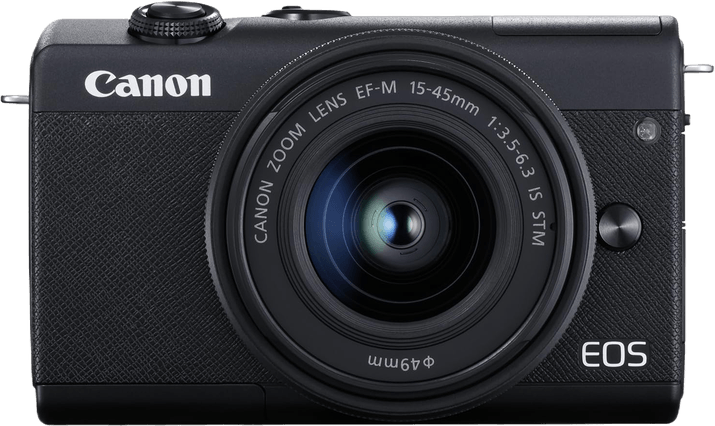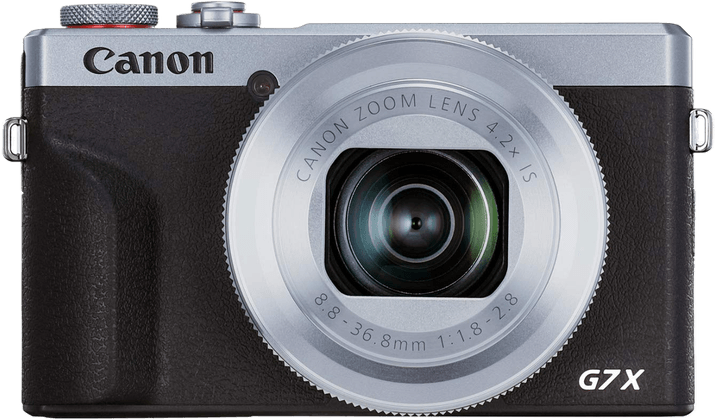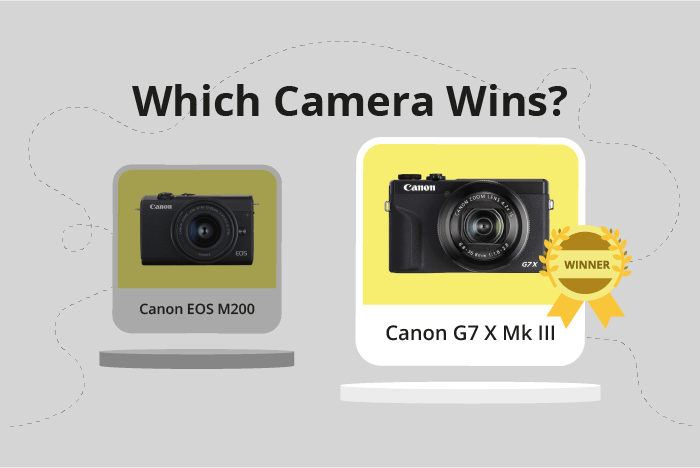Canon EOS M200 vs PowerShot G7 X Mark III Comparison
Canon EOS M200

Canon PowerShot G7 X Mark III

The Canon EOS M200 and the Canon PowerShot G7 X Mark III share some common specifications, such as their 2019 release year and similar announcement dates. However, there are differences that set them apart.
The EOS M200, a mirrorless camera, is lighter at 229g, and has a slightly larger body, measuring 108 x 67 x 35mm.
On the other hand, the PowerShot G7 X Mark III is a compact camera with a smaller size of 105 x 61 x 41mm but is heavier at 304g. Despite similar scores, the M200 offers a more budget-friendly option with a lighter body, while the G7 X Mark III provides a smaller, more portable design.
Canon M200 vs PowerShot G7 X Mark III Overview and Optics
The Canon EOS M200 narrowly wins against the Canon PowerShot G7 X Mark III in optics, with a score of 63/100 compared to 57/100. Both cameras share some common specifications, such as having a CMOS sensor and a Digic 8 processor.
The EOS M200 has some advantages over the G7 X Mark III. First, it has a higher megapixel count at 24 compared to 20, which translates to slightly better image resolution. Second, the M200 features an APS-C sensor size, which is larger than the G7 X Mark III’s 1″ sensor, allowing for better low light performance and dynamic range. Lastly, the M200 has a Canon EF-M lens mount, which provides the option to change lenses for different shooting scenarios.
On the other hand, the G7 X Mark III has its own strengths. The most notable advantage is its shooting speed of 30, which is significantly faster than the M200’s 6.1, making it more suitable for capturing fast-moving subjects. In addition, the G7 X Mark III has built-in image stabilization, unlike the M200, which helps reduce camera shake and results in sharper images.
While the EOS M200 has a slight edge in terms of optics, the PowerShot G7 X Mark III offers better shooting speed and image stabilization. Ultimately, the choice between the two cameras depends on the user’s priorities and preferences. If image quality and interchangeable lenses are of higher importance, the M200 would be the better choice. However, if shooting speed and image stabilization are more crucial, the G7 X Mark III would be the ideal option.
Canon EOS M200 vs PowerShot G7 X Mark III Video Performance
The Canon PowerShot G7 X Mark III outperforms the Canon EOS M200 in video capabilities with a score of 91/100, compared to the M200’s score of 83/100. Both cameras share impressive specifications, such as 4K max video resolution, video dimensions of 3840 x 2160, and built-in time-lapse functionality.
The G7 X Mark III offers a significant advantage in video frame rate, reaching up to 120fps, while the M200 only achieves 60fps. This higher frame rate allows for smoother and more detailed slow-motion footage, making the G7 X Mark III a better choice for videographers seeking advanced video features.
Although the EOS M200 falls short in frame rate, it still delivers solid video performance. With its 4K resolution and time-lapse functionality, the M200 is a suitable option for casual video shooters or those on a tighter budget. However, for those prioritizing video quality, the G7 X Mark III is the clear winner due to its superior frame rate.
To conclude, the Canon PowerShot G7 X Mark III is the better camera in terms of video capabilities, mainly because of its higher frame rate. The Canon EOS M200, while not as advanced, still offers respectable video performance for casual users. Ultimately, the choice between these two cameras depends on the user’s specific needs and priorities.
Canon EOS M200 vs PowerShot G7 X Mark III Features and Benefits
The Canon EOS M200 and the Canon PowerShot G7 X Mark III both have a feature score of 70 out of 100, making them equal in this aspect. They share several common specifications: a 3-inch screen size, a screen resolution of 1040000 dots, a touchscreen, a flip screen, GPS absence, WIFI, and Bluetooth connectivity.
The EOS M200 does not outperform the G7 X Mark III in any particular feature, as their specifications are identical. Both cameras provide a user-friendly interface, making them suitable for various photography needs. The touchscreen, flip screen, WIFI, and Bluetooth features enhance their usability and convenience.
Similarly, the G7 X Mark III does not surpass the EOS M200 in features. They both cater to the same target audience and offer equivalent functionality. The absence of GPS in both cameras might limit some users who require geotagging capabilities, but this does not affect their overall performance.
Since the Canon EOS M200 and the Canon PowerShot G7 X Mark III have the same feature score and identical specifications, neither camera is superior to the other. Users must base their decision on other factors, such as price, design, or personal preference. Both cameras are reliable options for photography enthusiasts, offering a range of useful features and delivering high-quality results.
Canon EOS M200 vs PowerShot G7 X Mark III Storage and Battery
The Canon PowerShot G7 X Mark III wins in the storage and battery category with a score of 27/100, compared to the Canon EOS M200’s score of 21/100. Both cameras share similarities in storage, as they each have one memory card slot and accept SD, SDHC, and SDXC (UHS-I compatible) cards.
The G7 X Mark III outperforms the M200 in terms of battery convenience, offering USB charging capability. This feature allows for easy charging on-the-go without needing a dedicated charger. However, the M200 has a longer battery life, providing 315 shots per charge compared to the G7 X Mark III’s 235 shots. This advantage makes the M200 more suitable for extended shooting sessions.
Despite the M200’s longer battery life, the G7 X Mark III’s USB charging feature and higher overall score make it the preferable choice in the storage and battery category.
Canon EOS M200 vs PowerShot G7 X Mark III – Our Verdict
Are you still undecided about which camera is right for you? Have a look at these popular comparisons that feature the Canon EOS M200 or the Canon PowerShot G7 X Mark III:

